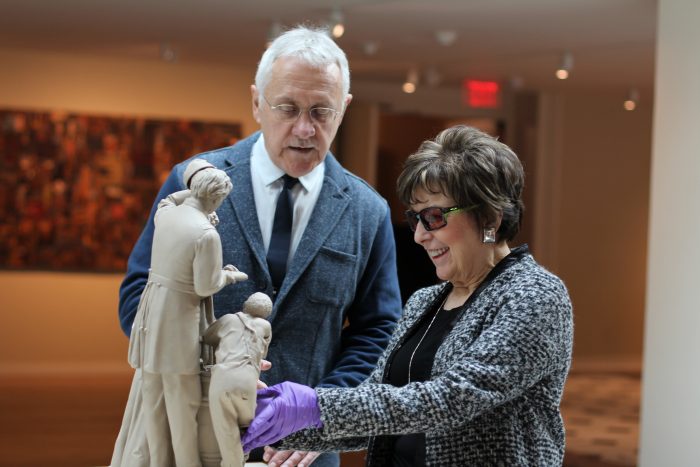SAAM’s Volunteer Docents: Celebrating a half-century of art education.
This year, the docent program of the Smithsonian American Art Museum is celebrating 50 years of artful conversations. Docents David Weisz and Jay Guerber take a look back—and ahead.

The Donald W. Reynolds Center for American Art and Portraiture, home of the Smithsonian American Art Museum and the National Portrait Gallery. Photo by Timothy Hursley
On May 3, 1968, the National Collection of Fine Arts—as SAAM was then known—opened its doors at the Old Patent Office building on 8th and G streets, NW. From day one, members of the docent corps were eagerly waiting to take visitors into the galleries and introduce them to the masterpieces in the collection. In the years since, docents have had a key role in making a trip to SAAM a rewarding experience for visitors.
After a recent tour of the highlights of SAAM’s permanent collection, a Canadian visitor noted that it was one of the best tours she had ever taken, citing in particular the “inquiry” method used by the docent to promote discussion and encourage connections between the artworks and their own lives. Over the years, many SAAM docents have used this touring method and have reported on experiences such as these:
- The first-grade girl who shyly watched as her mother, a chaperone on a school tour, interrupted a docent’s lunch to thank her for introducing her daughter to colorful abstract artworks, which the daughter had “absolutely loved.”
- The middle-school student who, noticing a dead tree in an otherwise sun-splashed painting, wondered if “something bad must have happened there,” thus prompting a solemn discussion among his classmates and their teacher.
- The two cardiologists who, on a docent-led tour of the Renwick Gallery, were excited to find a collapsed porcelain pot with an octopus painted on it. They connected it with the medical syndrome takatsubo (“octopus trap” in Japanese), or “broken heart syndrome” in layman’s terms. They later sent the docent an article from the Harvard Medical Journal that juxtaposed a photo of a Japanese octopus trap with an x-ray of a heart exhibiting that syndrome.

Docent Edmund Broder helps Jane Stanley explore a work of art through touch as part of the America InSight program at the Smithsonian American Art Museum.
The first SAAM docents were a select group. Nineteen women were recruited from two women’s organizations dedicated to volunteerism. They were trained to offer tours for “walk-in” visitors, adult groups, and schoolchildren.
In the years since 1968, much has changed—the museum spaces, the collection, our visitors, and our docent corps. SAAM’s permanent collection has grown to include acquisitions in folk and self-taught art, time-based media, and craft. The Renwick Gallery, focusing on American craft art, opened in 1972. The scope of the museum’s special exhibitions increased. Technological advances afforded new opportunities to reach far-flung audiences. Finally, visitor attendance has steadily risen in our galleries.
Concurrently, docent offerings and methods have adapted. Tour offerings are more inclusive, tailored to engage people with blindness or low-vision and those suffering memory loss and their care partners. There is also a corps of Deaf docents who lead tours for both Deaf and hearing visitors in American Sign Language. “Ask Me” docents are available for short-term, less formal interactions with visitors to the galleries. Docents conduct videoconferences, introducing the museum’s collections to schools and other facilities across the United States, Mexico, and Canada through SAAM’s distance learning program. The museum’s in-person outreach services have also expanded with docents traveling to area retirement communities, rehabilitation facilities, and organizations serving at-risk youth.

Peg Koetsch of the American Art Museum leads an in-gallery training session for volunteer video conference presenters.
However, the longevity and success of the docents’ work can’t be attributed only to an expanded collection, new technologies, and increased responsibilities. Another factor comes into play, and it is critical. In a series of recent interviews, SAAM docents—both experienced and newly-trained—were asked what they most appreciated in the program. Their responses revealed a common thread: the great majority of them stressed the collegiality and mutual support provided by their fellow docents as well as by SAAM staff; SAAM’s docent corps is a strong and vibrant community.
A range of intangible factors serve to bring the docents closer together and create a collegiality that makes adjusting to change a smooth process. Each new docent class is trained as a cohort, working together for several months, one or two days a week. This fosters camaraderie and a willingness to contribute to the many docent-run committees and working groups that, along with staff, serve to guide the work of the corps. Constant training is offered, a key means of adjusting to the new roles that docents have had to adopt over the years.
Beyond the formal training, monthly meetings, curator-led introductions to new exhibitions, and on-going peer-to-peer education activities all contribute. Added to these are elective activities such as local fieldtrips as well as out-of-town travel to museums, artist studios, and other art-related venues to enhance docent learning. A docent book group, seminars on special topics, celebratory lunches, an online photo archive, and informal exchanges whenever docents gather in the docent resource center keep the members connected. All of these factors drive the longevity of the corps, keeping morale high and inspiring docents to go “above-and-beyond” in all phases of their work.

Docent Donna Cramer leads middle-school students in a a discussion of Jacob Lawrence’s “The Library” at the American Art Museum.
Docents are constantly encouraged to remain flexible and to be prepared for such eventualities as delayed or canceled tours, favorite artworks being removed from the galleries, technology glitches affecting videoconferences, and the need to replace fellow docents unable to appear for assigned tours. Docents always pitch in to ensure that the program continues apace—a gratifying feature of a close-knit corps. And the payoff is an extraordinary experience for visitors to SAAM and the Renwick.
Today’s SAAM docents are a group of 120 active educators with a variety of backgrounds and experiences, recruited through a series of competitive interviews and trained by SAAM staff in a comprehensive program. Many docents are long-time veterans of the program; indeed, the longest-serving active docent has been giving tours for 44 years! Closely behind we have docents who have volunteered for 42, 39, and 34 years respectively.
While SAAM’s docents are volunteers, they acknowledge that they’re compensated quite well. What can be more rewarding than memories such as those mentioned at the outset of this article—and hundreds of similar ones? While interacting with the public, the docents agree that they learn as they teach. And it’s just plain fun too!
Posted: 8 May 2018
-
Categories:
American Art Museum , Art and Design , Education, Access & Outreach , Volunteer Voices








